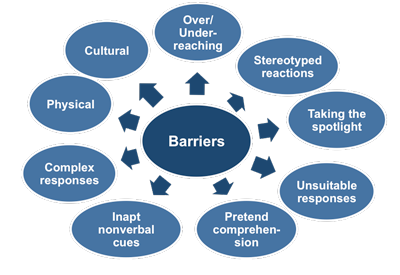Active Listening Skills - Barriers to Active Listening
To use the active listening techniques effectively, you need to put your personal feelings aside during the conversation, ask questions, and paraphrase the answers back to the speaker. Some of the barriers that can prevent a proper understanding of the issues involved include physical and cultural factors such as a noisy environment, a strong regional accent, or a difference in terms of reference.
 |
In addition to these external factors, which are usually fairly easy to overcome, there are some less obvious barriers that you should be aware of.
Inappropriate nonverbal cues
These include things like facing or leaning away from the other party, not maintaining eye contact, looking tense, or presenting a 'closed' posture by crossing your arms, etc. If what you say is being continually contradicted by your body language then there is no possibility of the other party opening up.
Your posture and gestures must always reflect that you are paying complete attention to the person speaking to you. Distractions force you to send inappropriate nonverbal signals to the speaker, and it only takes one such signal to destroy the benefits you can gain from active listening.
Taking the Spotlight
This refers to the tendency most people have to share equally in the conversation. It involves shifting from a passive role into an active one and effectively taking the focus of the encounter away from the other party and onto yourself. It can be difficult to avoid doing this once you feel as though you understand the issues involved.
Before you are tempted to take the spotlight remember that as soon as you begin giving advice or instructions you are no longer listening to the other party.
Stereotyped Reactions
When you are seeking clarification by using reflective questioning it is very easy to get into the habit of beginning your questions with phrases like:
'Are you saying that…?'
'Do you mean that…?'
If you are not careful with this type of questioning it can alienate the other party because it can sound patronizing. You should only use this type of reflective questioning when the meaning of something they have said actually needs clarifying.
Inappropriate Responses
If you are asked a direct question then the most appropriate response is usually to answer it rather than look for any deeper meaning. If the other party says
'When are we likely to get some extra resources?'
The best answer is usually a direct one. For example:
'We're getting two extra people next week.'
'I should know on Thursday.'
You can then proceed to ask more questions if you genuinely need clarification of something, but you should try to avoid answering direct questions with a question of your own, because it can make you appear vague or evasive.
Pretending Understanding
If you really don't understand what the other party is trying to say then you should always seek clarification in a direct way - for example, by saying something like 'Sorry, I didn't get that. What are you saying?'
Hoping that their meaning will eventually become clear is unnecessary and undermines the whole process. If you're confused by something that has been said, then say so and ask for an explanation.
Overreaching and Under-reaching
Overreaching involves ascribing meanings that go far beyond what the other party has expressed, by stating interpretations that are conjecture on your part. Under-reaching involves missing the meaning of what has been said because it does not agree with your own view of how things are.
It can be tempting to seek confirmation of your own views and you may need to make a conscious effort to avoid doing so.
Long-windedness
Giving very long or complex responses breaks the flow of the conversation and makes it less likely that you will gain an understanding of the other party's position. Short, simple responses are more effective.
Active Listening Tips - Good listeners' detach themselves from their own concerns, attitudes, and ideas whilst they are listening. You achieve this by removing such distractions allowing you to observe both the conscious and unconscious signs of the speaker. You are then able to identify any discrepancies between these two signs and discern the true meaning of what has been said.
You may also be interested in:
Active Listening Skills for Managers | Definition of Active Listening | Reflective Technique | Questioning Skills | Advantages of Active Listening.



